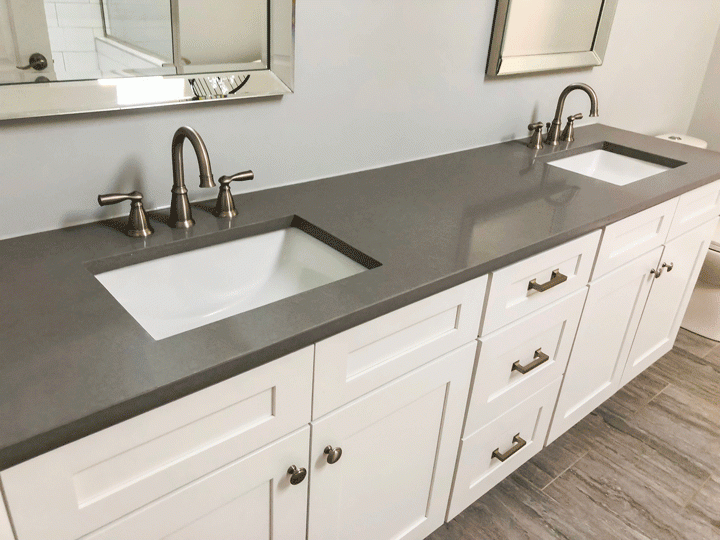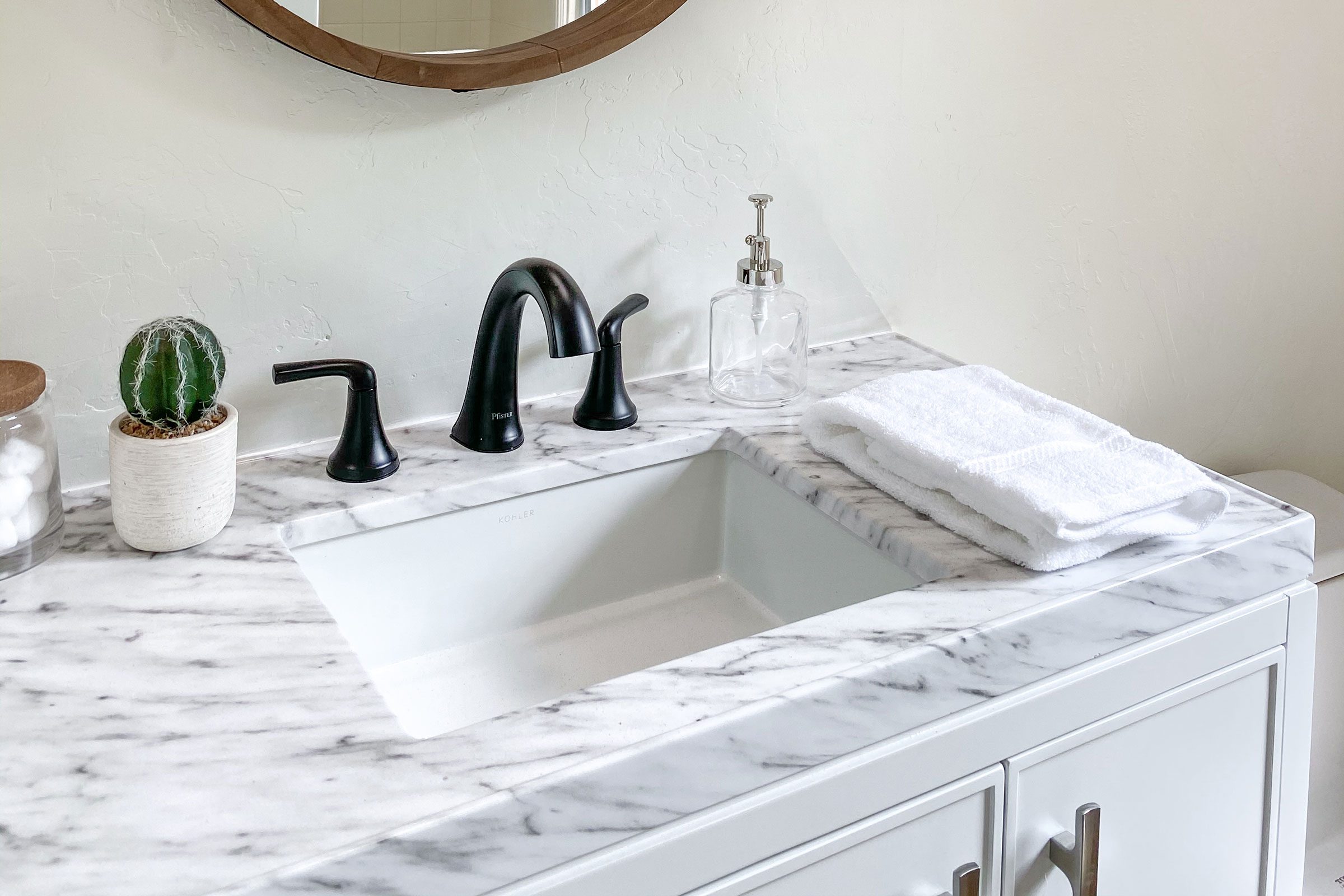Marble vs. Quartz: Marble Or Quartz In Bathroom

Choosing the right countertop material for your bathroom can be a tough decision, especially when you’re considering the luxurious elegance of marble against the practicality of quartz. Both offer unique advantages and disadvantages, making it crucial to weigh your priorities and lifestyle before making a final choice.
Durability and Stain Resistance
The durability and stain resistance of a countertop are crucial factors to consider, especially in a high-traffic area like a bathroom.
Marble, a natural stone, is known for its beauty and timeless appeal. However, it’s also porous, making it susceptible to scratches, etching, and stains.
Quartz, on the other hand, is an engineered stone, making it much more resistant to scratches, stains, and heat.
- Marble: Marble is a softer stone, making it prone to scratches and etching, particularly from acidic substances like lemon juice or vinegar. It requires careful maintenance and sealing to protect its surface.
- Quartz: Quartz is a much harder material, making it more resistant to scratches and etching. It’s also non-porous, making it less susceptible to stains.
Aesthetic Appeal
Both marble and quartz offer a wide range of colors and patterns to complement any bathroom design. However, they differ significantly in their aesthetic appeal.
- Marble: Marble boasts a natural elegance with unique veining patterns and subtle color variations, creating a truly one-of-a-kind look. This natural beauty can be a major selling point for homeowners who want a unique and luxurious feel in their bathroom.
- Quartz: Quartz countertops are available in a wide array of colors and patterns, including solid colors, speckled designs, and even imitations of marble. This versatility allows for a greater degree of customization, making it easier to match your bathroom decor.
Cost Considerations, Marble or quartz in bathroom
The cost of marble and quartz countertops can vary significantly depending on factors such as the quality of the material, the complexity of the installation, and the size of the countertop.
- Marble: Marble tends to be more expensive than quartz due to its natural origin and the labor-intensive process of extracting and finishing the stone.
- Quartz: Quartz is generally more affordable than marble, making it a more budget-friendly option for homeowners. It’s also easier to install, which can further reduce overall costs.
Maintenance Requirements
Both marble and quartz require regular cleaning and maintenance to keep them looking their best. However, their maintenance needs differ significantly.
- Marble: Marble requires more frequent sealing and cleaning to prevent staining and etching. It’s also important to avoid using harsh cleaning products that can damage the surface.
- Quartz: Quartz is relatively low-maintenance, requiring only regular cleaning with mild soap and water. Its non-porous surface makes it resistant to stains and etching, reducing the need for frequent sealing.
Practical Considerations for Bathroom Surfaces

Choosing the right surface for your bathroom is crucial, as it will impact its functionality, aesthetics, and longevity. Both marble and quartz offer unique benefits, but understanding their practical considerations is essential to make an informed decision.
Bathroom Floor Considerations
The bathroom floor is a high-traffic area prone to moisture and foot traffic. Here’s a breakdown of how marble and quartz perform in this setting:
- Marble: Marble is naturally porous and can be susceptible to staining and etching from acidic substances like cleaning products or spilled liquids. However, it’s also a beautiful and luxurious material that can add a touch of elegance to your bathroom. Regular sealing is crucial to protect marble floors from damage.
- Quartz: Quartz is non-porous and stain-resistant, making it a more practical choice for bathroom floors. It’s also durable and scratch-resistant, making it suitable for high-traffic areas. However, quartz can be less forgiving if dropped objects are heavy or sharp.
Bathroom Wall Considerations
Bathroom walls are also exposed to moisture and humidity, making it essential to select a material that can withstand these conditions.
- Marble: Marble is a beautiful and elegant material that can add a touch of luxury to your bathroom walls. However, its porous nature makes it susceptible to water damage and staining. Regular sealing is crucial to protect marble walls from damage.
- Quartz: Quartz is a more practical choice for bathroom walls due to its non-porous nature, making it resistant to water damage and staining. Quartz is also durable and scratch-resistant, making it suitable for high-traffic areas. However, quartz can be less forgiving if dropped objects are heavy or sharp.
Shower Surround Considerations
The shower surround is one of the most challenging areas in a bathroom, as it is constantly exposed to water and moisture.
- Marble: Marble can be a beautiful and luxurious choice for shower surrounds. However, its porous nature makes it susceptible to water damage, mold growth, and staining. Regular sealing is crucial to protect marble shower surrounds from damage.
- Quartz: Quartz is a more practical choice for shower surrounds due to its non-porous nature, making it resistant to water damage and mold growth. Quartz is also durable and scratch-resistant, making it suitable for high-traffic areas. However, quartz can be less forgiving if dropped objects are heavy or sharp.
Cleaning and Maintaining Marble and Quartz Surfaces
Regular cleaning and maintenance are crucial to preserve the beauty and longevity of your bathroom surfaces.
Cleaning Marble Surfaces
- Sweep or vacuum: Remove any loose dirt or debris from the surface.
- Use a mild cleaner: A solution of warm water and mild dish soap is generally sufficient for cleaning marble surfaces. Avoid using acidic cleaners, such as vinegar, as they can etch the surface.
- Rinse thoroughly: Rinse the surface with clean water to remove any soap residue.
- Dry the surface: Dry the surface with a clean cloth to prevent water spots.
- Seal regularly: Seal marble surfaces every 6-12 months to protect them from staining and etching.
Cleaning Quartz Surfaces
- Sweep or vacuum: Remove any loose dirt or debris from the surface.
- Use a mild cleaner: A solution of warm water and mild dish soap is generally sufficient for cleaning quartz surfaces.
- Rinse thoroughly: Rinse the surface with clean water to remove any soap residue.
- Dry the surface: Dry the surface with a clean cloth to prevent water spots.
Potential Issues with Water Damage, Mold Growth, and Other Bathroom Problems
Both marble and quartz can be susceptible to water damage, mold growth, and other bathroom problems if not properly maintained. However, quartz is generally more resistant to these issues due to its non-porous nature.
Marble
- Water damage: Marble is porous and can absorb water, which can lead to staining and etching. It’s important to seal marble surfaces regularly to prevent water damage.
- Mold growth: Mold can grow in damp areas, especially in porous materials like marble. It’s important to keep marble surfaces clean and dry to prevent mold growth.
Quartz
- Water damage: Quartz is non-porous and resistant to water damage. However, it’s still important to clean up spills promptly to prevent staining.
- Mold growth: Quartz is resistant to mold growth due to its non-porous nature. However, it’s still important to keep quartz surfaces clean and dry to prevent mold growth.
Design Inspiration

Marble and quartz are both beautiful and versatile materials that can be used to create stunning bathroom designs. They each offer unique characteristics that can be incorporated to achieve a variety of styles, from classic to modern.
Marble Bathroom Design
Marble is a timeless material that adds elegance and sophistication to any bathroom. It’s known for its luxurious look and feel, and its natural veining adds a unique touch to every piece. Here’s a visual representation of a bathroom design using marble for the countertop and shower walls:
Imagine a spacious bathroom with natural light streaming in through large windows. The countertop is crafted from a stunning slab of Calacatta marble, its white background punctuated by dramatic grey veining. This veining continues onto the shower walls, creating a cohesive and luxurious look. The floor is made of polished porcelain tiles in a soft grey hue, complementing the marble and creating a sense of continuity. Sleek, brushed nickel fixtures add a modern touch, while a freestanding soaking tub provides a luxurious centerpiece. Plants add a touch of greenery and life to the space. This bathroom embodies a classic, yet modern, style, showcasing the timeless beauty of marble.
Quartz Bathroom Design
Quartz is a more durable and practical choice than marble, making it ideal for high-traffic areas like bathrooms. It comes in a wide variety of colors and patterns, allowing for endless design possibilities. Here’s an example of a bathroom space incorporating quartz countertops and complementary materials like wood, tile, and metal fixtures:
Imagine a bathroom with a warm, inviting atmosphere. The countertop is crafted from a quartz slab with a warm, earthy tone, mimicking the look of natural stone. This countertop is paired with dark wood cabinets, adding a touch of rustic charm. The shower walls are clad in large format porcelain tiles that mimic the look of natural stone, creating a cohesive and sophisticated look. The floor is made of wood-look porcelain tiles, adding warmth and texture to the space. Sleek, black metal fixtures add a modern touch, while a large walk-in shower with a rain showerhead provides a luxurious and spa-like experience. This bathroom blends modern and traditional elements, creating a stylish and functional space.
Bathroom Styles and Material Integration
Marble and quartz can be integrated into various bathroom styles to achieve a desired aesthetic. Here are examples of how these materials can be used in different bathroom styles:
Modern Bathroom
* Marble: A sleek, minimalist countertop made from honed or polished white marble with subtle grey veining would complement a modern bathroom design.
* Quartz: A quartz countertop in a solid white or grey color with a matte finish would provide a clean and contemporary look.
Traditional Bathroom
* Marble: A classic white marble countertop with prominent veining would add a touch of elegance to a traditional bathroom.
* Quartz: A quartz countertop with a warm, earthy tone and a honed finish would complement the traditional aesthetic.
Minimalist Bathroom
* Marble: A minimalist bathroom design could feature a simple, rectangular countertop made from honed white marble with minimal veining.
* Quartz: A quartz countertop in a solid white or grey color with a matte finish would enhance the minimalist aesthetic.
Marble or quartz in bathroom – The choice between marble and quartz for your bathroom countertop is a reflection of your personal style and values. If you seek a timeless elegance that evokes a sense of history and grandeur, consider a victorian style bathroom vanity paired with the cool, classic beauty of marble.
Marble’s natural veining adds a touch of the divine to your sanctuary, reminding you of the intricate patterns woven into the fabric of existence.
The choice between marble and quartz for your bathroom is a reflection of your personal style and the energy you wish to cultivate. Marble, with its natural veining, brings a sense of grounding and connection to the earth, while quartz, with its smooth, polished surface, evokes a sense of purity and clarity.
If you’re drawn to a more vibrant and uplifting atmosphere, consider incorporating the refreshing hues of a yellow and green bathroom , which can be beautifully complemented by the timeless elegance of either marble or quartz.